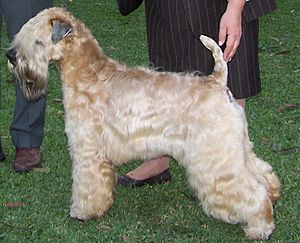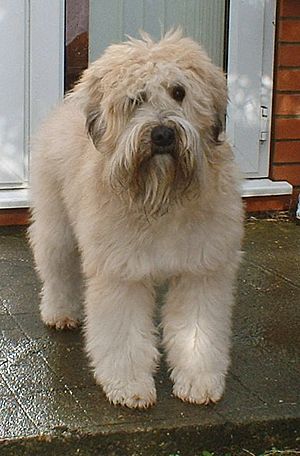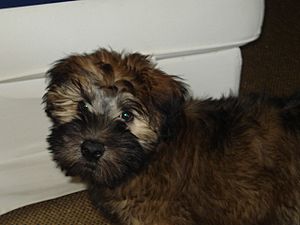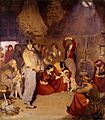Soft-coated Wheaten Terrier facts for kids

Soft-coated Wheaten Terrier standing as if at a conformation dog show
|
|||||||||||||||||||||||||||||||||
| Other names | Irish Soft-Coated Wheaten Terrier and variant spellings: "Soft Coated" and "Softcoated" |
||||||||||||||||||||||||||||||||
|---|---|---|---|---|---|---|---|---|---|---|---|---|---|---|---|---|---|---|---|---|---|---|---|---|---|---|---|---|---|---|---|---|---|
| Common nicknames | Wheaten or Wheatie | ||||||||||||||||||||||||||||||||
| Origin | Ireland | ||||||||||||||||||||||||||||||||
|
|||||||||||||||||||||||||||||||||
|
|||||||||||||||||||||||||||||||||
| Domestic dog (Canis lupus familiaris) | |||||||||||||||||||||||||||||||||
The Soft-coated Wheaten Terrier is a special type of dog that comes from Ireland. Its name in Irish means "Yellow Terrier." These dogs usually have one of two kinds of coats: the Irish type or the American type. The Irish coat feels silkier and is wavier. The American coat is thicker and fuller. Wheatens are known for being friendly and playful. They often get along well with kids and other dogs.
Contents
History of the Wheaten Terrier
For more than 200 years, Wheatens were bred in Ireland to be helpful farm dogs. Their jobs included guiding animals, guarding livestock, and hunting small pests. They are related to other Irish dog breeds like the Kerry Blue Terrier and the Irish Terrier. However, wealthy people did not own Wheatens. In Ireland, they were often called the "Poor Man's Wolfhound." In the past, their tails were sometimes shortened to avoid taxes.
Even with their long history, the Irish Kennel Club did not officially recognize the Wheaten as a breed until 1937. The British Kennel Club also recognized them in 1943. The first Wheatens came to the United States in the 1940s. But people didn't become very interested in them until about ten years later.
The Soft Coated Wheaten Terrier Club of America was started in 1962. This was seven years after a similar club began in Great Britain. In the 1970s, Wheatens were brought to Australia. By 1973, the American Kennel Club officially recognized the breed. Today, Wheatens take part in dog sports like obedience, agility, and tracking. They are also sometimes used to help people in animal-assisted therapy.
What a Wheaten Terrier Looks Like
When Wheaten puppies are born, their coats can be dark. They might be red, brown, or even white. Their noses and ears can be black or dark brown. As they grow, their reddish-brown puppy fur slowly turns almost white. Then, it changes into the wheaten (wheat-colored) coat they have as adults. This adult coat usually fully develops by the time they are three years old. It might have some black, white, or darker brown hairs mixed in. If an adult Wheaten gets a skin injury, the new hair that grows there will be the dark color of their puppy coat at first. It will eventually change back to the wheaten color.
The Soft-coated Wheaten Terrier is a medium-sized dog. They are usually about 43 to 50 cm (17 to 20 inches) tall. They weigh about 13.6 to 20 kg (30 to 45 pounds). They have a strong, well-built body. Their soft, silky hair does not shed much, like human hair or Poodle hair. Instead, it keeps growing. Because of this, they need to be trimmed regularly. They also need to be brushed and combed every day to stop their fur from getting tangled. Wheatens are very smart dogs and are easy to train. They love people and usually do not have problems with aggression if they come from a good breeder.
The Irish coat type is often thinner and silkier than the American type. Many people in Ireland and Europe prefer this coat. They believe it is the original coat for a working dog. Some breeders in the US and Canada also raise Irish-type Wheatens. Even the Irish coat needs daily brushing to prevent mats.
You can see what Wheatens looked like long ago in the famous painting "The Aran Fisherman's Drowned Child" by Irish artist Frederic William Burton. The dogs in Ireland today look very similar to those shown over 100 years ago.
Wheaten Terrier Health
Soft-coated Wheaten Terriers generally live a long time. Like all dog breeds, they can get certain health problems that are passed down through their families. Two conditions they are known for involve losing protein. One is called protein-losing nephropathy (PLN), where their kidneys lose protein. The other is protein-losing enteropathy (PLE), where their bodies don't properly absorb protein from their food. Both PLN and PLE can be serious. But if they are found early, they can sometimes be managed with special diets and medicines.
Other health issues that Wheatens can have include kidney problems, digestive issues, and some types of cancer. Some Wheatens might also have allergies to food or things in their environment. This can sometimes lead to skin problems. If you are thinking about getting a Wheaten puppy, it's a good idea to talk to the breeder about these health concerns.
Wheaten Terrier Temperament
The Soft-coated Wheaten Terrier is a very energetic and playful dog. They need patient and consistent training using positive methods. Being too harsh with them can make them scared or aggressive. A kind and steady approach works best with these smart but sometimes stubborn dogs. They are very excited to meet new people. They often jump up to lick a person's face, which is sometimes called the "Wheaten greetin'."
Wheatens are usually less aggressive than other terrier breeds. But they are lively and can be more active than many other dogs. Because of this, they need regular exercise to stay happy and healthy. They prefer cooler weather and can get too hot easily in warm climates.
If Wheatens are raised with cats and other puppies, they usually get along well. If not, you should be careful when introducing them to cats. This breed has a strong "prey drive" because they were originally bred to hunt small animals. Wheatens are friendly and loving pets. They get along well with other dogs if they are properly socialized. They are also very protective of their families. While they might bark to alert you to strangers, they rarely become aggressive. Many Wheaten owners say they make great watch dogs, but not good guard dogs. Wheatens are generally friendly and make great dogs for children.
Images for kids
See also
 In Spanish: Irish soft coated wheaten terrier para niños
In Spanish: Irish soft coated wheaten terrier para niños




